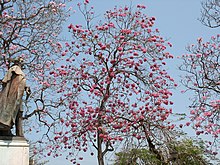Tabebuia rosea
| Tabebuia rosea | |
|---|---|

| |
| Scientific classification | |
| Kingdom: | Plantae |
| Clade: | Tracheophytes |
| Clade: | Angiosperms |
| Clade: | Eudicots |
| Clade: | Asterids |
| Order: | Lamiales |
| Family: | Bignoniaceae |
| Genus: | Tabebuia |
| Species: | T. rosea
|
| Binomial name | |
| Tabebuia rosea DC. | |
| Synonyms[1] | |
|
List
| |
Tabebuia rosea, also called pink poui, and rosy trumpet tree
Names
The tree is known as "tekoma" in Malaysia.[4]
The tree is known as "රොබරෝසියා (Robarōsiyā)" in Sri Lanka.[5]
The tree is known as "ชมพูพันธุ์ทิพย์" in Thailand.[6]
Distribution and habitat
This species is distributed from southern
This tree is often seen in
Description
The tree is short length, with irregular, stratified
Medicinal uses
Preparations of the bark of the tree are consumed to eliminate intestinal parasites, malaria and uterine cancer. A decoction of the bark is recommended for anemia and constipation. A decoction of the flowers, leaves and roots has been used to reduce fevers and pain, cause sweating, to treat tonsil inflammation and various other disorders.[3]
Among the various active phytochemicals in the tree is lapachol, a natural organic compound isolated from various other Tabebuia species.[7] Chemically, it is a derivative of naphthoquinone, related to vitamin K.
Once studied as a possible treatment for some types of cancer, lapachol's potential is now considered low due to its toxic side effects.[8][9][10][11] Lapachol also has antimalarial and antitrypanosomal effects.[12]
References
- ^ "The Plant List: A Working List of All Plant Species". Retrieved June 3, 2014.
- ^ "Tabebuia rosea". Germplasm Resources Information Network. Agricultural Research Service, United States Department of Agriculture. Retrieved 15 September 2015.
- ^ a b Hernan Rodriguez Navas. 2007. La Utilidad de las Plantas Medicinales en Costa Rica. EUNA, Heredia, Costa Rica. 213pp.
- ^ "Kuala Lumpur becomes an enchanting 'Sakura' paradise". Free Malaysia Today. 25 March 2021. Retrieved 27 March 2021.
- ^ "රෝස පැහැ වසන්තය රොබරෝසියා - perabeats Life Articles". perabeats. 2019-06-18. Retrieved 2022-09-23.
- ^ "ชมพูพันธุ์ทิพย์ ต้นชมพูพันธุ์ทิพย์ ชมพูอินเดีย ไม้ต้นขนาดกลางถึงใหญ่". baanlaesuan (in Thai). 2023-02-27. Retrieved 2023-05-15.
- ^ Record, Samuel J. Lapachol. Tropical Woods (1925), 1 7-9.
- PMID 12413627.
- ^ Oral toxicology studies with lapachol. Morrison, Robert K.; Brown, Donald Emerson; Oleson, Jerome J.; Cooney, David A. Toxicology and Applied Pharmacology (1970), 17(1), 1-11.
- PMID 11340475.
- PMID 17421057.
- ^ Gupta, M. 1995. 270 Plantas Medicinales Iberoamericanas. Santa Fe de Bogota. Convenio Andres Bello.



